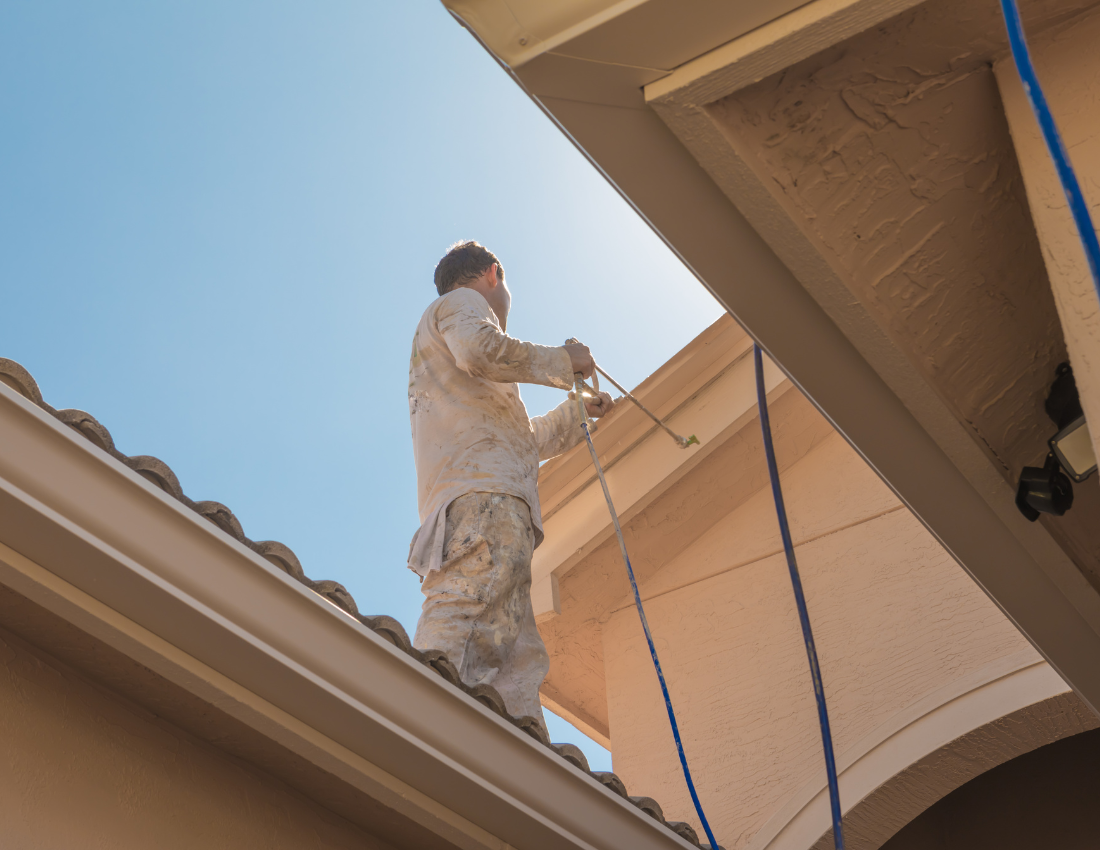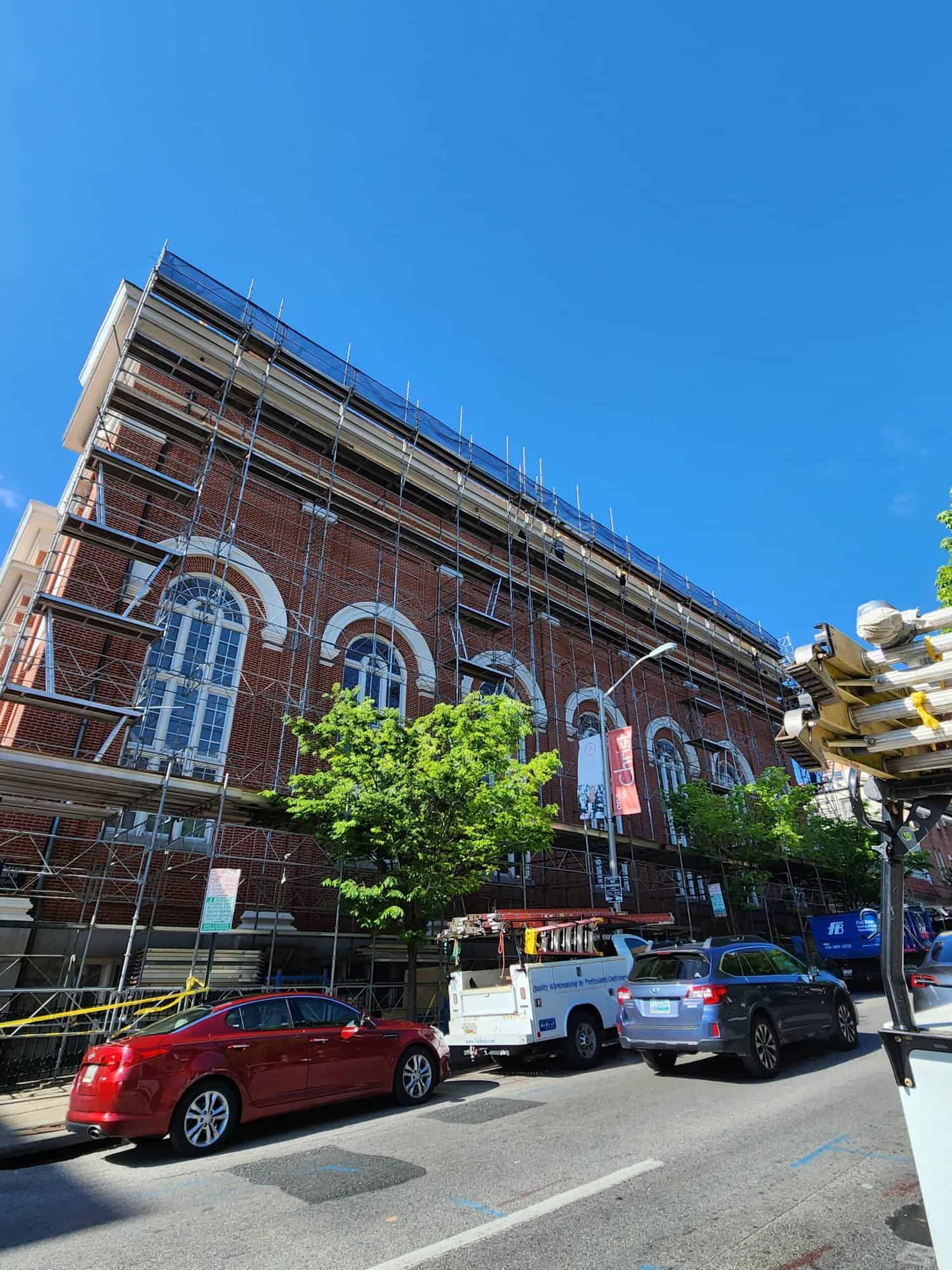If you’re planning a painting project, you’ve probably asked yourself: Should I use a paint sprayer or a roller?
It’s a common debate, and the answer depends on your project, experience, and the finish you want. Roller painting vs spray painting is about choosing the right tool for the job.
Sprayers can apply paint quickly and create a smooth, even coat, making them perfect for large areas or textured surfaces. Rollers, on the other hand, offer more control and are great for precise applications like interior walls and ceilings.
If you’re tackling a house painting project, understanding the pros and cons of each method can help you get the best results. We’ll cover when to use a roller, when a sprayer makes sense, and how house painters in Roland Park, MD handle different painting projects.
Key Takeaways:
- Roller painting vs spray painting depends on the project size, surface type, and level of detail needed.
- Paint sprayers are ideal for large areas, textured surfaces, and furniture refinishing, providing a smooth, factory-like finish but requiring more prep work and paint.
- Rollers offer better paint efficiency, easier control, and less prep, making them the best choice for interior walls, ceilings, and small projects.
- Sprayers work best for exterior walls, masonry, and ceilings, while rollers are more practical for occupied spaces and budget-conscious projects.
- Beginners will find rollers easier to handle, while sprayers require skill and practice to avoid overspray, drips, and uneven coats.
- The right painting method depends on speed, cost, and experience level—for professional results, house painters in Roland Park, MD can help with either technique.
When a Paint Sprayer is the Best Choice

A paint sprayer is a high-speed tool designed to apply paint evenly and efficiently by releasing a fine mist of paint particles. This method produces a smooth, factory-like finish that’s hard to achieve with a paint roller or brush. It’s especially useful for large surfaces, intricate textures, or hard-to-reach areas where a roller may struggle.
The Advantages of Spray Painting
Cover More Area in Less Time
One of the biggest advantages of using a paint sprayer is its ability to cover large areas quickly. Unlike a roller, which requires multiple strokes and reloading with paint, a sprayer evenly distributes paint in a continuous, fine mist.
This means finishing projects faster and with less physical effort. A sprayer is ideal for painting garage doors, fences, and masonry walls, where rolling would be time-consuming. It’s also a great option for ceilings, where a paint roller can leave roller marks or make application difficult.
However, while speed is a major benefit, it’s essential to prepare the area properly. Since a sprayer disperses paint particles into the air, you need to mask off any areas you don’t want painted to avoid unwanted overspray.
Perfect for Textured Surfaces
If your walls or ceilings have stucco, brick, or a popcorn ceiling texture, applying paint with a roller can be a challenge. These surfaces have deep crevices, and rollers may struggle to push paint into every nook and cranny.
A paint sprayer, on the other hand, applies a fine mist that settles evenly over textured surfaces, ensuring full coverage without the need for multiple passes. This makes spray painting an excellent option for exterior painting, brick walls, or decorative molding with intricate details.
For homeowners updating a home’s exterior, using a sprayer helps achieve better adhesion and a smoother finish, especially on masonry and concrete surfaces.
Flawless Finish on Furniture and Cabinets
If you’re working on furniture, kitchen cabinets, or built-ins, achieving a smooth, professional-grade finish is important. Using a brush or roller can sometimes leave behind visible streaks or a slight texture, even when applying multiple coats.
A paint sprayer eliminates this problem by providing an ultra-smooth, even coat without brush strokes or roller marks. This is why many professional painters in Roland Park MD use sprayers for cabinet painting, woodworking, and refinishing furniture pieces.
However, because sprayers produce fine mist particles, you’ll need proper ventilation and personal protective equipment, including a mask, to avoid inhaling paint fumes.
Challenges of Spray Painting
While spray painting offers numerous benefits, it does come with some drawbacks. Understanding these challenges can help you decide whether a sprayer is the right tool for your project.
Requires Extensive Masking
One major downside of spray painting is that it requires extensive masking to protect areas you don’t want painted. Since the paint mist spreads beyond the intended surface, everything from windows to flooring, baseboards, and even ceiling fans needs to be covered.
If you’re painting a room that contains furniture or carpet, you’ll need to take extra precautions to prevent overspray from settling on unwanted surfaces. This means spending additional time using drop cloths, plastic sheeting, and painter’s tape before you can even begin painting.
While masking ensures a clean application, it does make the prep process longer compared to roller painting, which only requires basic protection for floors and baseboards.
Uses More Paint = Higher Costs for Materials
Compared to a paint roller, spray painting tends to use more paint. Since some paint is lost in the air during application, more material is required to achieve full coverage.
This can drive up costs, especially when using high-quality acrylic paint or oil-based paint. If you’re working on a budget, a roller may be the better option for controlling paint consumption while still achieving solid adhesion.
Additionally, because sprayers require consistent refilling, you may go through paint faster than expected, especially on large projects like exterior walls or garage doors.
Takes Skill to Avoid Mistakes
Using a paint sprayer isn’t as simple as pulling a trigger and spraying away. It requires practice and technique to achieve an even application without drips, runs, or thin spots.
Beginners often struggle with:
- Controlling the nozzle. Spraying too close can lead to thick layers that run, while spraying too far away can result in thin, patchy coats.
- Managing pressure settings. Adjusting the pressure incorrectly can cause paint buildup or inconsistent coverage.
- Avoiding uneven drying. Sprayers apply paint faster, but if coats overlap poorly, it can cause an uneven finish.
It’s recommended to practice on a scrap surface before using a sprayer on walls, furniture, or cabinetry. If you’re unsure, hiring house painters in Roland Park MD can ensure a flawless finish without the frustration of trial and error.
Best Projects for Spray Painting
Not all painting projects require a sprayer, but for certain surfaces, it’s the best choice. Here’s when you should consider spray painting:
- Exterior Walls and Masonry: Great for brick, stucco, and large masonry surfaces where a roller would take too long.
- Textured Surfaces: Works well for popcorn ceilings, decorative molding, and intricate woodwork.
- Furniture and Cabinets: Provides a sleek, factory-like finish for kitchen cabinets, dresser sets, and bookshelves.
- Ceilings and Crown Molding: Reduces roller marks and helps with detailed applications.
- Large Surfaces: Ideal for garage doors, fences, sheds, and other wide areas that need quick coverage.
If your painting project involves any of these surfaces, a sprayer can be a game-changer in achieving professional results. However, if you’re painting a small room, bathroom, or occupied space, roller painting may be the easier and more practical solution.
When a Paint Roller is the Right Choice

Roller painting is a reliable, cost-effective, and beginner-friendly way to apply paint evenly without the overspray issues that come with spray painting. If you’re painting interior walls, ceilings, or small areas, a paint roller gives you more control while using less paint.
Unlike paint sprayers, which require masking, ventilation, and personal protective equipment, roller painting is a straightforward process with minimal prep work. If you’re unsure about roller painting vs spray painting, consider how much time, skill, and material cost you’re willing to invest.
The Benefits of Roller Painting
Less Waste, More Coverage
One of the biggest advantages of using a paint roller is paint efficiency. Rollers apply paint directly to the surface, minimizing waste compared to a sprayer, which loses paint particles in the air. This means you get better coverage per gallon of paint, which is ideal for those working with a budget or high-end acrylic paint.
Since roller painting allows for controlled application, it also helps with paint adhesion, reducing the risk of peeling or chipping over time. If you’re looking for a healthier option when painting interior walls, it’s worth considering the type of paint you use. Low-voc paint vs regular explains the differences between these paint types, helping you choose one that suits your indoor air quality needs while still delivering excellent coverage.
Easier for Beginners
If you’ve never painted before, a roller is by far the easiest tool to use. Unlike sprayers, which require nozzle adjustments, pressure control, and overspray management, roller painting is simple:
- Load the roller in a paint tray
- Apply even strokes across the surface
- Reload and repeat until full coverage is achieved
A paint roller provides consistent results with minimal effort, making it an excellent choice for DIYers. It’s also forgiving—if you make a mistake, you can simply go over the area again without having to sand down drips or deal with overspray cleanup.
Less Prep Work: Minimal Masking Required
Compared to spray painting, roller painting requires far less masking. Since paint rollers don’t create overspray, you only need to protect baseboards, floors, and furniture with a drop cloth—not the entire room.
This makes roller painting ideal for:
✔ Occupied homes. No need to clear out an entire room before painting
✔ Small projects. Quick touch-ups or a single accent wall
✔ Budget-friendly jobs. Less paint waste, so you save money on materials
Roller painting is the go-to method for interior painting in homes with furniture, carpet, or delicate fixtures. If you want a hassle-free way to update a room, roller painting is the practical choice.
Challenges of Roller Painting
While roller painting has clear advantages, it’s not the perfect solution for every project. Before choosing a roller, consider the following downsides:
Takes More Time
A paint sprayer can cover a wall in minutes, while a roller requires multiple passes and physical effort to get the same coverage. If you’re painting a large space, roller painting will take longer than spray painting.
For example, painting a garage door or masonry with a roller may take several hours, while a sprayer could complete the job in a fraction of the time. If speed is your main priority, a paint sprayer might be the better option.
Not Ideal for Rough or Textured Surfaces
While rollers work great on smooth walls, they struggle to reach deep crevices on stucco, brick, or popcorn ceilings. Textured surfaces require more effort and often need multiple coats to get full coverage.
If you’re working with a rough texture, using a high-nap roller can help, but it won’t be as efficient as a sprayer. For house painters in Roland Park MD, sprayers are often the preferred choice for masonry and wood paneling because they apply paint evenly across uneven surfaces.
Best Projects for Roller Painting
Not all painting projects require a sprayer. Here’s when you should stick to a roller:
- Interior walls and ceilings
- Occupied spaces
- Budget-friendly projects
- Touch-ups and small areas
- DIY home improvement
If your painting project involves any of these, a roller is likely the better choice. However, for large areas, textured surfaces, or outdoor projects, a paint sprayer may be more efficient.
Beyond choosing the right painting method, color selection also plays a huge role in transforming a space. If you’re working with a small room and want to create the illusion of more space, check out how to make a room look bigger with paint for expert tips on selecting paint colors that enhance depth and openness.
Roller Painting vs Spray Painting Comparison
Still debating roller painting vs spray painting? Here’s a quick comparison to help you decide:
| Feature | Spray Painting | Roller Painting |
|---|---|---|
| Speed | Faster, covers large areas | Slower but more controlled |
| Finish | Smooth, factory-like finish | Slight texture but even coverage |
| Paint Efficiency | Uses more paint, higher waste | Uses less paint, budget-friendly |
| Prep Work | Extensive masking required | Minimal prep needed |
| Ease of Use | Requires skill and technique | Beginner-friendly |
No matter which method you choose, getting a professional-looking finish depends on prep work, the number of paint coats, and the right materials.
How FR Contractors and Investors, Inc. Can Help with Your Painting Project
FR Contractors and Investors, Inc. takes the guesswork out of roller painting vs spray painting. Our process ensures a smooth, high-quality finish every time:
- Surface Preparation: We clean, pressure wash, and prime surfaces for the best adhesion.
- Professional Masking & Protection: We cover floors, baseboards, and furniture to prevent overspray.
- Expert Application: Whether we use rollers, sprayers, or paintbrushes, we tailor the method to each surface.
- Final Touch-Ups & Cleanup: We leave your space looking fresh with no mess left behind.
Whether you’re painting a room, refinishing kitchen cabinets, or updating your garage door, we’re here to help. Call us at 443-775-2994 for a FREE estimate in Towson, Yorktown, Phoenix, MD, and the surrounding areas today!




